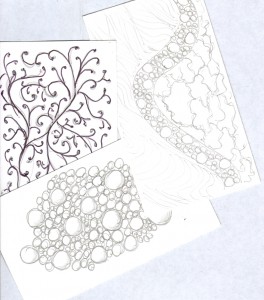Is doodling a dying art?
With the proliferation of iPads, smart phones and other personal electronic devices, we spend less and less time with a pen or pencil (or in my case, a crayon) in hand. Sit in on any business meeting and at least one person will be frantically tapping away at their touch screen – taking detailed notes. Certainly not checking Facebook or reading email.
At seminars and workshops, it can be hard to hear the speaker over the clicking of keys. Then there’s the whole hazard caused by power cords competing for the few accessible outlets. Battery technology isn’t quite up to handling 7 or 8 hours of constant typing.
This is totally off topic but I have to get it down before I lose it. There should be a “typing section” for compulsive computer based note takers (maybe charge a premium for these seats). Then provide an outlet tucked under each seat, with a single, safely routed cable to power the individual outlets. Brilliant! Please feel free to take this idea and put it to use.
I seem to have wondered off topic (squirrel!) Back to doodling.
Why might someone (you perhaps) want to doodle? There are actually benefits to indulging in this seemingly aimless act.
Memory – A study done in 2009 suggests that doodling can increase information retention by as much as 30%. When listening to calls, speeches, lectures or webinars, the mind is occupied just enough while doodling to keep it from wandering off in daydreams, but not so much that it isn’t paying attention. When your 3rd grade teacher yelled at you for not paying attention because you were doodling, she was wrong (probably, she was wrong when she yelled at me anyway).
Do you suppose if the madly typing note takers were doodling instead, they might remember enough of the material that all those detailed notes wouldn’t be necessary? There goes the market for my selective seating idea – oh well, I was giving it away anyway.
Creativity and problem solving – Doodling is more than just making random squiggles on page or screen. It is actually thinking in disguise. If you can distract your busy brain by giving it something “mindless” to do, your subconscious or unconscious has a chance to work on problems or projects you have been struggling with. Solutions may appear in the doodles or rise up to your awareness because they’re not being drowned out by all that monkey-mind chatter. Doodling in this way is much like meditation but since you’re actually busy doing “something” the chatter is easier to keep at bay.
For the truly electronically addicted, there are dozens of doodling programs and apps available for download. So you can doodle on your device and avoid all that messy paper and pen stuff. Try it at the next seminar you attend. If you ask nicely, maybe they’ll let you sit in the typing only section.



I LOVE the doodle!!!! Keep up the good work! It’s definitely therapeutic.
Kathyrn,
I love this idea. Here, here for doodling!!
for us computer-connected types, love your chord chair idea. Did you know there’s a program called Doodle.com for scheduling (meetings, walks with friends, etc.) It’s a super helpful program so you don’t have to sift through dozens of emails just to pick a date everyone is available for Armand’s chicken cacciatore! Gee, I wonder what they were doing when they invented such a creative and useful program – doodling, maybe?
Now I know one more English word. Have found myself doodling many a times just did not know that was what I was doing.
Thanks Kerry I like it!